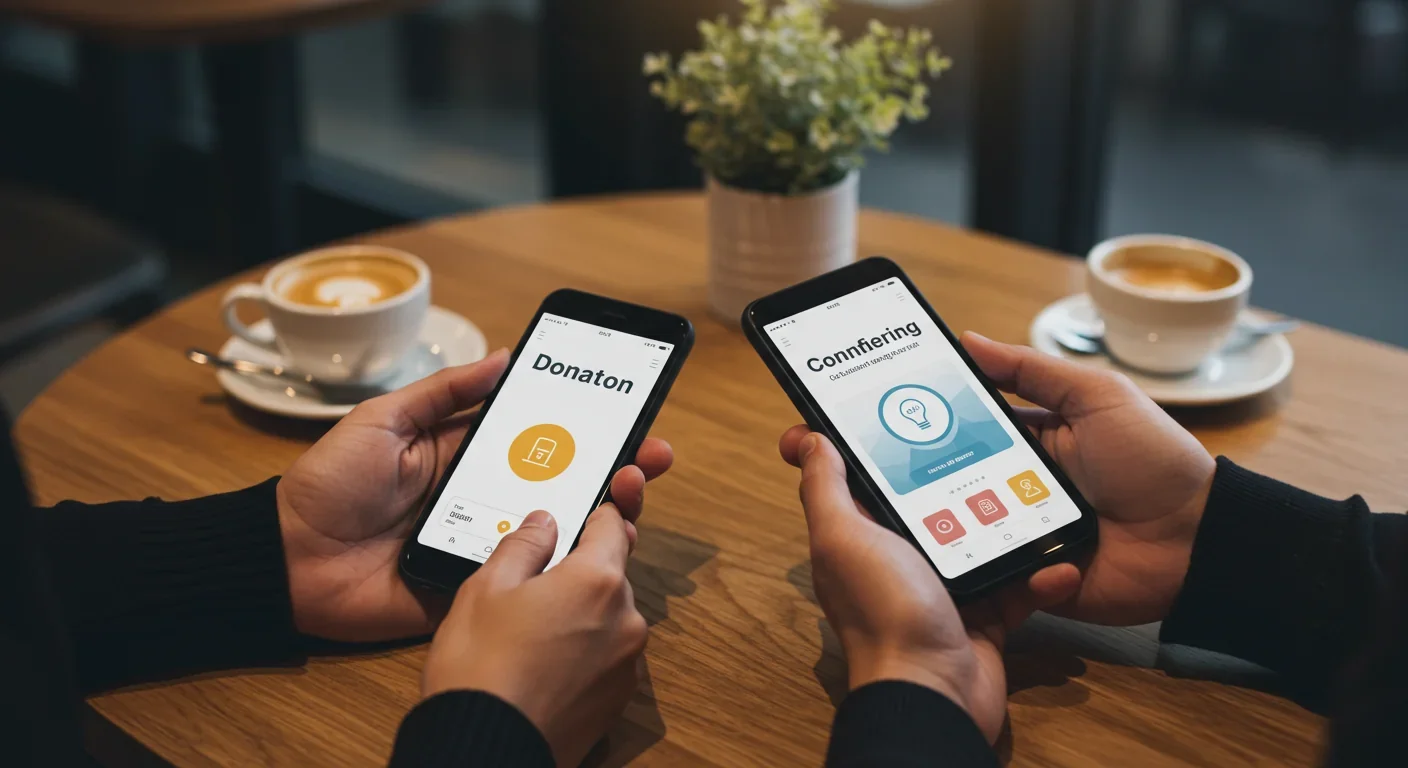Epigenetic Clocks Predict Disease 30 Years Early

TL;DR: Social media has created a trauma economy where personal suffering is monetized through platforms like TikTok, Patreon, and GoFundMe, raising ethical questions about exploitation, mental health impacts, and the commodification of pain.

The wildfire survivors who lost everything found themselves facing a strange new task: crafting the perfect GoFundMe pitch. Their homes were still smoldering when they had to decide how much trauma to reveal, which photos would generate the most donations, and whether to share their children's tears. Welcome to the trauma economy, where personal suffering has become a monetizable commodity and authenticity is measured in engagement metrics.
Over the past five years, something fundamental has shifted in how we share pain online. What began as genuine human connection has morphed into a complex ecosystem where algorithms reward emotional intensity, platforms take their cut, and creators face an impossible choice: monetize their trauma or watch others do it for them.
The infrastructure for profiting from suffering didn't emerge overnight. It's built on platforms that have perfected the art of turning emotional engagement into revenue streams.
TikTok generated $23.6 billion in revenue in 2024, largely by amplifying emotionally charged content through its Creator Fund and ad-sharing programs. Creators discussing mental health crises, relationship breakdowns, or personal tragedies can earn between $0.02 and $0.04 per 1,000 views. That might sound negligible, but trauma content routinely generates millions of views because algorithms prioritize high-engagement material, and few things engage like raw pain.
YouTube operates differently but achieves similar results. While the platform has strict demonetization policies around "controversial" content, creators have learned to navigate these rules by framing trauma narratives as educational or inspirational. YouTube's machine-learning model reduced flagged extremist videos by 30 percent in 2023, but trauma content occupies a gray zone that's harder to police.
Patreon represents the subscription model of trauma monetization. The platform hosts over 250,000 creators, many of whom offer exclusive access to their most vulnerable moments for paying subscribers. Patreon processed over $3.5 billion in cumulative payments by 2024, with mental health and personal development categories showing the fastest growth.
Then there's crowdfunding. GoFundMe has facilitated over $30 billion in donations since its launch, with medical emergencies and disasters driving the majority of campaigns. During the 2025 California wildfires, thousands of campaigns appeared within hours, each competing for attention in a saturated market of suffering.
Understanding why trauma content proliferates requires understanding how platforms decide what you see. Algorithms are computerized rules that examine user behavior and rank content based on likes, comments, shares, and watch time. They're optimization machines, and trauma optimizes beautifully.
When someone posts about their divorce, their child's illness, or their assault, the emotional intensity triggers what researchers call "high-arousal emotions" that drive engagement. People stop scrolling. They watch longer. They comment more. These feedback loops prioritize emotionally provocative posts, creating a perverse incentive structure where the most painful moments become the most valuable content.

Social media algorithms impact mental health by creating echo chambers of emotional content. If you engage with one trauma post, you'll see dozens more, training both audiences and creators about what performs. This isn't conspiracy, it's mathematics seeking to maximize time on platform.
The algorithmic push creates what some call "grief labor." Research on Instagram influencers who share bereavement content reveals how creators feel pressure to perform resilience while simultaneously displaying enough vulnerability to maintain authenticity. It's exhausting emotional work that pays in currency and attention.
Creating trauma content isn't a neutral act. It changes the creator's relationship with their own pain in ways that mental health professionals are only beginning to understand.
Trauma dumping research shows that when creators repeatedly share distressing experiences without appropriate boundaries, they can experience retraumatization. The act of packaging pain for consumption forces a strange emotional distance where the creator simultaneously relives the experience and performs it for an audience.
What writer Darren McGarvey calls the "trauma industrial complex" describes how some creators become trapped in narratives of suffering. Once a creator builds an audience around their trauma, there's enormous pressure to continue delivering that content. Recovery or healing can feel like betraying your followers or losing your income stream.
The psychological impact manifests in several ways. Some creators develop what therapists call performative vulnerability, where they share increasingly personal information not for catharsis but because the algorithm demands it. Others experience desensitization to their own pain, treating their trauma as content raw material rather than lived experience.
Research on grief labor documents creators who felt compelled to post about deceased loved ones on death anniversaries because their audience expected it, turning private mourning into public performance. The emotional authenticity that initially connected them with followers becomes a job requirement.
Consumers of trauma content face their own psychological challenges. Trauma dumping on social media causes distress for viewers who weren't prepared for the emotional intensity of what they encountered.
Platforms offer little control over when traumatic content appears in feeds. Someone scrolling for entertainment can suddenly encounter detailed descriptions of abuse, graphic health updates, or footage of disasters. This unpredictability creates what psychologists call "vicarious trauma" where viewers develop trauma symptoms from repeated exposure to others' suffering.
There's also the phenomenon of parasocial relationships, where viewers develop one-sided emotional bonds with creators. These relationships create illusions of closeness that make viewers feel personally invested in creators' trauma, sometimes leading to emotional exhaustion or compassion fatigue.
Research on parasocial relationships and consumer trust reveals how these dynamics influence spending behavior. Viewers who feel connected to a creator's struggle are more likely to donate, subscribe, or purchase products, creating financial incentives for maintaining the parasocial bond through continued trauma sharing.

The constant exposure also contributes to societal desensitization. When every crisis is monetized and publicized, it becomes harder to distinguish genuine emergencies from performative suffering, leading to donor fatigue and cynicism.
Where money flows through emotional vulnerability, fraud follows. Fraudulent crowdfunding campaigns have become sophisticated enough to fool even experienced donors.
After major disasters, fake campaigns appear within hours, featuring stolen photos and fabricated stories. The Lapu Lapu tragedy in the Philippines generated dozens of fraudulent GoFundMe campaigns that collectively raised hundreds of thousands of dollars before being shut down. The case highlighted the need for vigilance and oversight in crowdfunding platforms.
Some fraud is more subtle. Creators might exaggerate symptoms, fabricate relapses, or manufacture drama to maintain engagement. The line between authentic sharing and performance becomes genuinely unclear when financial survival depends on audience sympathy.
Platforms struggle to police authenticity without invading privacy. GoFundMe states that it reviews suspicious campaigns, but with millions of active fundraisers, enforcement remains inconsistent. The burden often falls on donors to verify claims, which few have time or resources to do.
Governments and regulatory bodies are beginning to address the trauma economy, but legislation lags far behind platform innovation.
The FTC issued updated guidelines for influencers in 2023, requiring disclosure of material connections between endorsers and advertisers. These rules theoretically apply to trauma content when creators promote products or services, but enforcement is rare because proving that trauma sharing constitutes endorsement is legally complex.
FTC requirements for influencers mandate clear disclosure when receiving compensation, but many trauma creators argue their content is personal sharing, not advertising, even when monetized through platform programs.
YouTube's demonetization policies create another layer of complexity. The platform restricts monetization on content discussing sensitive topics including self-harm, eating disorders, and abuse, ostensibly to protect vulnerable viewers. However, these policies can silence authentic discussions while leaving sensationalized trauma content untouched.
Critics argue that demonetization policies shape public discourse by determining which conversations about suffering are commercially viable. Mental health advocates can't earn revenue from educational content about suicide prevention, while vague "wellness" influencers monetize mental health struggles without oversight.
Emerging regulations around AI and grief present new challenges. Research on griefbots and AI regulation explores how artificial intelligence is being used to create digital avatars of deceased loved ones, raising questions about consent, exploitation, and the commercialization of memory itself.
Despite the perverse incentives, some creators have developed frameworks for sharing trauma responsibly.
Authentic storytelling with a trauma-informed approach emphasizes consent, context, and purpose. Before sharing, creators ask: Does this serve a purpose beyond engagement? Have I processed this sufficiently to share it safely? Am I prepared for the audience response?
Mental health professionals recommend what they call boundaries around trauma dumping. These include content warnings, limiting detail, and clearly stating whether the creator wants advice or simply to share. These practices protect both creator and audience.
The difference between trauma bonding and authentic bonding matters here. Healthy creator-audience relationships shouldn't depend on shared suffering but on shared growth, learning, or community. Creators who share recovery journeys rather than just crises build more sustainable communities.
Some creators have adopted transparency about monetization. They explicitly state when content is sponsored, when they're earning from views, and how donations are used. This honesty helps audiences make informed choices about their financial and emotional investment.
Therapists using social media provide a model for ethical engagement with difficult topics. They share educational content about trauma without exploiting individual stories, maintain clear professional boundaries, and regularly assess whether their content helps or harms their audience.
Viewers aren't powerless in this economy. Conscious consumption of trauma content starts with awareness.
First, recognize signs of performative vulnerability: consistent oversharing without progression, trauma content that always appears at optimal posting times, or narratives that escalate whenever engagement drops. These patterns suggest content is being optimized for algorithms rather than shared for healing.
Set personal boundaries. Therapists recommend limiting exposure to trauma content, unfollowing accounts that consistently leave you drained, and using platform tools to filter sensitive topics. Your mental health matters more than any creator's engagement metrics.
Before donating to crisis campaigns, verify claims. Look for updates, cross-reference information, check if the creator has a history of fundraising, and consider donating to established organizations rather than individuals when possible.
Support creators who prioritize healing over performance. Subscribe to, share, and engage with content that shows growth, recovery, and resilience rather than just ongoing crisis. Economic incentives follow attention, so audiences can influence what types of content get made.
Understand how algorithms affect what you see. If your feed is dominated by trauma content, actively engage with different types of posts to retrain your algorithm. The more you interact with balanced, informative content, the less trauma content platforms will serve you.
The trauma economy isn't disappearing. Personal storytelling has value, and platforms have no incentive to change systems that drive engagement. But we can navigate this landscape more thoughtfully.
Platforms could implement waiting periods before trauma content is monetizable, similar to how GoFundMe holds funds for verification. They could provide mental health resources to creators whose content suggests crisis. Better algorithmic design could prioritize educational trauma content over raw suffering.
Creators need better support systems. Mental health consultation before and during trauma content creation, financial planning that doesn't depend on ongoing crisis, and community standards that value recovery as much as revelation.
Audiences need media literacy education about parasocial relationships, trauma dumping dynamics, and the commercial structures underlying the content they consume. Understanding the trauma economy's mechanics helps people engage with it consciously rather than being manipulated by it.
The fundamental question isn't whether people should share their pain online. Human connection through shared vulnerability has existed long before social media and will continue after it. The question is whether we can create systems that support healing rather than exploitation, that reward growth rather than perpetual crisis, and that recognize the difference between authentic storytelling and trauma performance.
Right now, the trauma economy rewards those who can package their pain most palatably, maintain crisis long enough to build an audience, and navigate platform policies while maximizing emotional impact. We can do better. We must do better. Because behind every view count and donation total is a real person whose suffering shouldn't be optimized for engagement metrics.

Recent breakthroughs in fusion technology—including 351,000-gauss magnetic fields, AI-driven plasma diagnostics, and net energy gain at the National Ignition Facility—are transforming fusion propulsion from science fiction to engineering frontier. Scientists now have a realistic pathway to accelerate spacecraft to 10% of light speed, enabling a 43-year journey to Alpha Centauri. While challenges remain in miniaturization, neutron management, and sustained operation, the physics barriers have ...

Epigenetic clocks measure DNA methylation patterns to calculate biological age, which predicts disease risk up to 30 years before symptoms appear. Landmark studies show that accelerated epigenetic aging forecasts cardiovascular disease, diabetes, and neurodegeneration with remarkable accuracy. Lifestyle interventions—Mediterranean diet, structured exercise, quality sleep, stress management—can measurably reverse biological aging, reducing epigenetic age by 1-2 years within months. Commercial ...

Data centers consumed 415 terawatt-hours of electricity in 2024 and will nearly double that by 2030, driven by AI's insatiable energy appetite. Despite tech giants' renewable pledges, actual emissions are up to 662% higher than reported due to accounting loopholes. A digital pollution tax—similar to Europe's carbon border tariff—could finally force the industry to invest in efficiency technologies like liquid cooling, waste heat recovery, and time-matched renewable power, transforming volunta...

Humans are hardwired to see invisible agents—gods, ghosts, conspiracies—thanks to the Hyperactive Agency Detection Device (HADD), an evolutionary survival mechanism that favored false alarms over fatal misses. This cognitive bias, rooted in brain regions like the temporoparietal junction and medial prefrontal cortex, generates religious beliefs, animistic worldviews, and conspiracy theories across all cultures. Understanding HADD doesn't eliminate belief, but it helps us recognize when our pa...

The bombardier beetle has perfected a chemical defense system that human engineers are still trying to replicate: a two-chamber micro-combustion engine that mixes hydroquinone and hydrogen peroxide to create explosive 100°C sprays at up to 500 pulses per second, aimed with 270-degree precision. This tiny insect's biochemical marvel is inspiring revolutionary technologies in aerospace propulsion, pharmaceutical delivery, and fire suppression. By 2030, beetle-inspired systems could position sat...

The U.S. faces a catastrophic care worker shortage driven by poverty-level wages, overwhelming burnout, and systemic undervaluation. With 99% of nursing homes hiring and 9.7 million openings projected by 2034, the crisis threatens patient safety, family stability, and economic productivity. Evidence-based solutions—wage reforms, streamlined training, technology integration, and policy enforcement—exist and work, but require sustained political will and cultural recognition that caregiving is ...

Every major AI model was trained on copyrighted text scraped without permission, triggering billion-dollar lawsuits and forcing a reckoning between innovation and creator rights. The future depends on finding balance between transformative AI development and fair compensation for the people whose work fuels it.